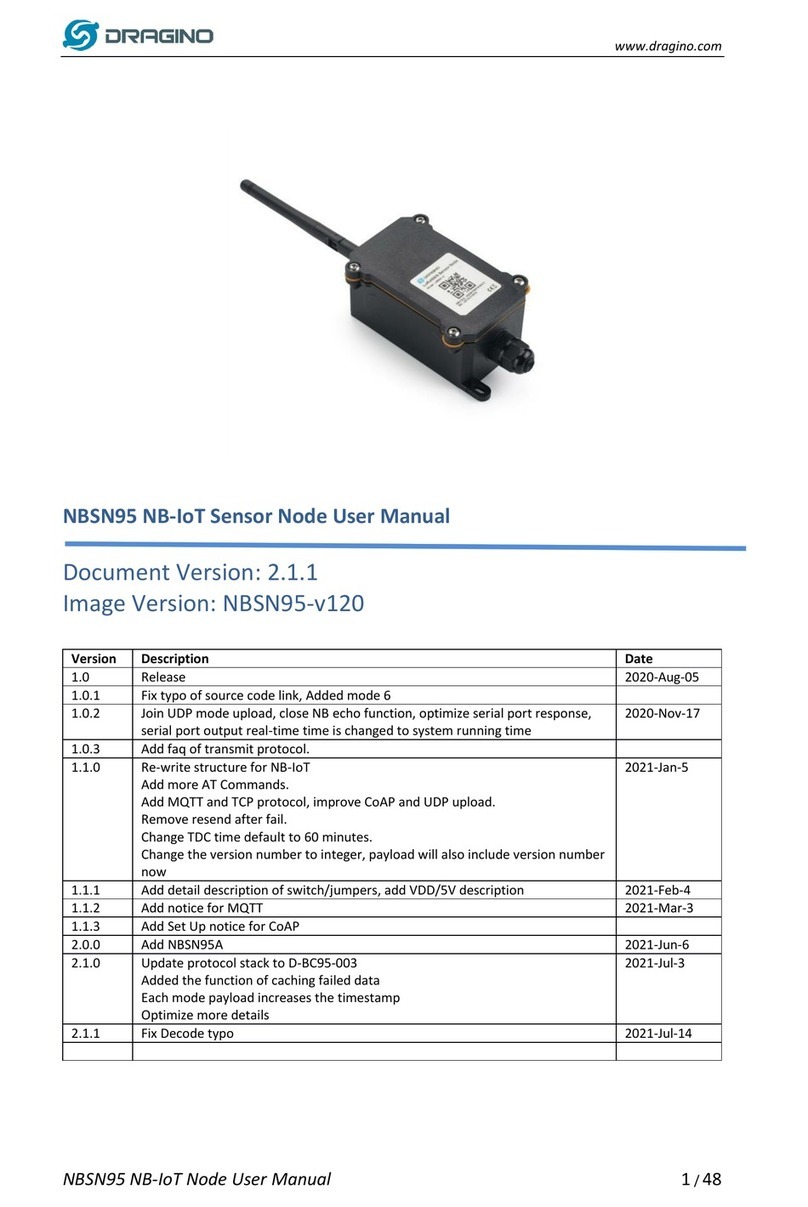
User Manual for LoRaWAN End Nodes - LHT65N LoRaWAN Temperature & Humidity Sensor Manual
Table of Contents
1. Introduction .......................................................................................................................................................................... 5
1.1 What is LHT65N Temperature & Humidity Sensor .................................................................................................. 5
1.2 Features .......................................................................................................................................................................... 5
1.3 Specification ................................................................................................................................................................... 5
2. Connect LHT65N to IoT Server ....................................................................................................................................... 6
2.1 How does LHT65N work? ........................................................................................................................................... 6
2.2 How to Activate LHT65N? ........................................................................................................................................... 6
2.3 Example to join LoRaWAN network ........................................................................................................................... 7
2.3.1 Step 1: Create Device n TTN ................................................................................................................................ 7
2.3.2 Step 2: Activate LHT65N by pressing the ACT button for more than 5 seconds. .......................................... 12
2.4 Uplink Payload ............................................................................................................................................................. 12
2.4.1 Decoder in TTN V3 ............................................................................................................................................... 13
2.4.2 BAT-Battery Info .................................................................................................................................................... 13
2.4.3 Built-in Temperature ............................................................................................................................................. 14
2.4.4 Built-in Humidity ..................................................................................................................................................... 15
2.4.5 Ext # ........................................................................................................................................................................ 15
2.4.6 Ext value ................................................................................................................................................................. 15
2.5 Show data on Datacake ............................................................................................................................................. 17
2.6 Datalog Feature ........................................................................................................................................................... 20
2.6.1 Ways to get datalog via LoRaWAN .................................................................................................................... 20
2.6.2 Unix TimeStamp .................................................................................................................................................... 20
2.6.3 Set Device Time .................................................................................................................................................... 21
2.6.4 Poll sensor value ................................................................................................................................................... 21
2.6.5 Datalog Uplink payload ........................................................................................................................................ 22
2.7 Alarm Mode ................................................................................................................................................................. 24
2.8 LED Indicator ............................................................................................................................................................... 25
2.9 installation ..................................................................................................................................................................... 25
3. Sensorsand Accessories ................................................................................................................................................ 26
3.1E2 Extension Cable ..................................................................................................................................................... 26
3.2E3 Temperature Probe ............................................................................................................................................... 26
4. Configure LHT65N via AT command or LoRaWAN downlink .................................................................................... 27
4.1 Set Transmit Interval Time ........................................................................................................................................ 27
4.2 Set External Sensor Mode ......................................................................................................................................... 28
4.3 Enable/Disable uplink Temperature probe ID ......................................................................................................... 28
4.4 Set Password .............................................................................................................................................................. 29
4.5 Quit AT Command ...................................................................................................................................................... 29
4.6 Set to sleep mode ....................................................................................................................................................... 30
4.7 Set system time ........................................................................................................................................................... 30
4.8 Set Time Sync Mode .................................................................................................................................................. 30
4.9 Set Time Sync Interval ............................................................................................................................................... 31
4.10 Print data entries base on page. ............................................................................................................................. 31
4.11 Print last few data entries. ....................................................................................................................................... 32
4.12 Clear Flash Record ................................................................................................................................................... 33
4.13 Auto Send None-ACK messages ........................................................................................................................... 33
5. Battery & How to replace ................................................................................................................................................ 34
5.1 Battery Type ................................................................................................................................................................ 34
5.2 Replace Battery ........................................................................................................................................................... 34
5.3 Battery Life Analyze .................................................................................................................................................... 35
6. FAQ .................................................................................................................................................................................... 35
6.1 How to use AT Command? ....................................................................................................................................... 35
6.2 Where to use AT commands and Downlink commands ........................................................................................ 39
6.3How to change the uplink interval? ...................................................................................................................... 43
6.4How to use TTL-USB to connect a PC to input AT commands? .......................................................................... 44
Page 1 / 56 - last modified by Bei Jinggeng on 2022/07/06 13:48




























